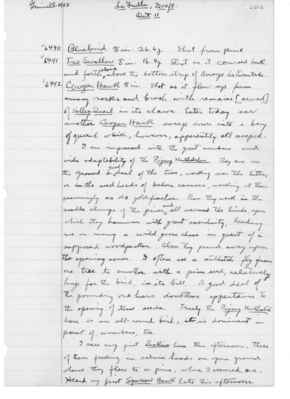Pages That Mention Valley Quail
1925: Joseph Grinnell's field notes
S2 Page 4
Collector: Grinnell - 1925 Location: Lassen Section Date: June 12, 1925 Page Number: 2460
slopes of Inskip Hill); Calif. Woodpecker; Nuttall Woodpecker; Calif. Purple Finch (very common and in full song here in the black oaks); Linnet (equally common and in full song); Western Tanager (one in full song, as I write); Cassins Vireo and Western Warbling Vireo (equally in evidence); Wood Pewee (common); Ash-Throated Flycatcher ( "buckaroo" song heard early in the morning from slopes of Inskip Hill; Black-Throated Gray Warbler (several singing males); Lutescent Warbler (one singing male) Western Lark Sparrow (several); Western Chipping sparrow (common and singing); Green-backed Goldfinch (singing birds almost continually within hearing); Wren-tit (heard song from bushy slopes of Inskip Hill; Valley Quail (sentinel call of male in distance); Plain Tit (one pair, in black oaks); Slender-billed Nuthatch (very common); Bullock Oriole (one heard); Morning Dove (several have flown past); The "stream" right here is now dry - all the water taken out for the ranches around Payne Creek P.O. But down below here a few rods a narrow canyon begins, cut down thru the lava cap, and there, there are potholes with water, the source, apparently, for the birds of these woods. Along the ravine are luxurious golden oaks, densely blooming syringia (Philadelphus), ash trees, etc. Up in the rocky walls are bushes of Cercis and Rhus Trilobata.
S3 Page 39
Collector: Grinnell - 1925 Location: La Grulla, 7200 ft. Date: Oct. 11 Page Number: 2582 6490 Bluebird (male sign) im. 26.6g. Shot from pine. 6491 Tree Swallow (male sign) im. 16.4g. Shot as it coursed back and forth alone above the bottom strip of Arroyo La Encantada. 6492 Cooper Hawk. (male sign) im. Shot as it flew up from among rocks and brush with remains [saved] of Valley Quail in its claws. Later today saw another Cooper Hawk sweep down into a bevy of quail which, however, apparently all escaped. I am impressed with the great numbers and wide adaptability of the Pigmy Nuthatches. They are on the ground a good deal of the time, working over the litter; or in the seed heads of Salvia carnosa, working at them seemingly as do goldfinches. Then they work in the needle clumps of the pines, and all around the limbs upon which they hammer with great assiduity, leading me on many a wild goose chase in quest of a supposed woodpecker. Also they pound away upon the opening cones. I often see a nuthatch fly from one tree to another with a pine seed, relatively huge for the bird, in its bill. A good deal of the pounding one hears doubtless appertains to the opening of these seeds. Truly the Pigmy Nuthatch here is an all-round bird; it is dominant in point of numbers, too. I saw my first Siskins here this afternoon, three of them feeding in salvia heads on open ground whence they flew to a pine, where I secured one. Heard my first Sparrow Hawk late this afternoon.
S3 Page 53
Collector: Grinnell - 1925 Location: San Jose, 2500 ft., Lat. 31 degrees Date: October 19, 1925 Page Number: 2596
There was a little seepage there, and some rainwater in granite bowls in the stream-course. Large numbers of Valley Quail centered there. The following are the birds I saw, by individuals, from memory; but there were so few, I believe I am close & correct. Red-shafted Flicker (2); San Lucas Flycatcher (1, shot); Calif Jay (10±) Audubon Warbler (16±); Ruby-crown Kinglet (1); Spotted Towhee (5); Brown Towhee (4); Green-backed Goldfinch (1); Lawrence Goldfinch (1, seen and heard in flight overhead); Intermediate Sparrow (20±); Bell Sparrow (2); Calif. Thrashers (3); Shrike (one, very shy, seen and heard repeatedly, but refused to be stalked); Bewick Wren (3); Rock Wren (2); Valley Quail (40±). Horseback is a good way of taking a census, as it increases the range of vision, though chances of hearing high-pitched voices are less because of the squeakings of the saddle, rattle of the bit-chain, etc. I rather think that a foot in most productive, as a person can stop instantly, in perfect quiet, and listen and look; while the horse takes time to come to a standstill and even then fidgets. Of mammals, I saw one Jack Rabbit, and one Bush Rabbit, the latter, as usual in Adenostoma bush. Large bare areas in the mesa, adjacent to sage-bush and juniper, showed great amounts of Dipodomys sign — of the same sort as where I am trapping, near the ranch; this is of the heermanni or paramintinus kind and not of the agilis brand, it seems to me.
S3 Page 66
Collector: Grinnell - 1925 Location: to Colnett, Sat. 31 degrees Date: Oct. 28 Page Number: 2608
6641 Savannah Sparrow (female sign) im. 16.7g. Shot in salicornia. 6642 “ “ (female sign) im. 16.8.g. Shot on stem of clump of juncus.
Was out early 5:15 to 6:30, and again 9:20 to 11:30, the last time to the beach, the bluff, and the salt flats. Saw following birds: Turkey Vulture (4+); Poorwill (heard calling last evening); Valley Quail (2 large coveys near camp); Cactus Woodpecker (one heard); Say Phoebe (2); Anna Hummer (2, around blossoming Lycium); Brown Towhee (4+); Spotted Towhee (2); Rufous-crowned Sparrow (2); Intermediate Sparrow (12±); Calif. Thrasher (2, singing); Linnet (6±); Wren-tit (4+); Black-Tailed Gnatcatcher (2); Bewick Wren (2); Red-winged Blackbird (a pair visited camp, and others in small companies in flight out in the valley); Raven (within hearing most of the time); Meadowlark (4 or more, out in salt flat); Marsh Wren (common, a dozen or more, in dense mats of Salicornia (unknown 1) sloughs just back of the cobble-stone beach-barrier (which is fully 8 feet higher than the flats inland from it)); Savannah Sparrow (scattered troupes on open ground among small bushes back from the salicornia); Belding and Large-billed Sparrows (on salicornia marshes, not many, the latter also on beach at high-tide line of drift); Pipit (flock of 10± on bare alkali flat); Killdeer (one heard - the only wader, where we saw so many on the beach when we were here in September); Song Sparrow (2, in big juncus clumps up the valley from the salicornia. Of mammals, I saw one Jack Rabbit on salt flat and 2 or more Brush Rabbits.



